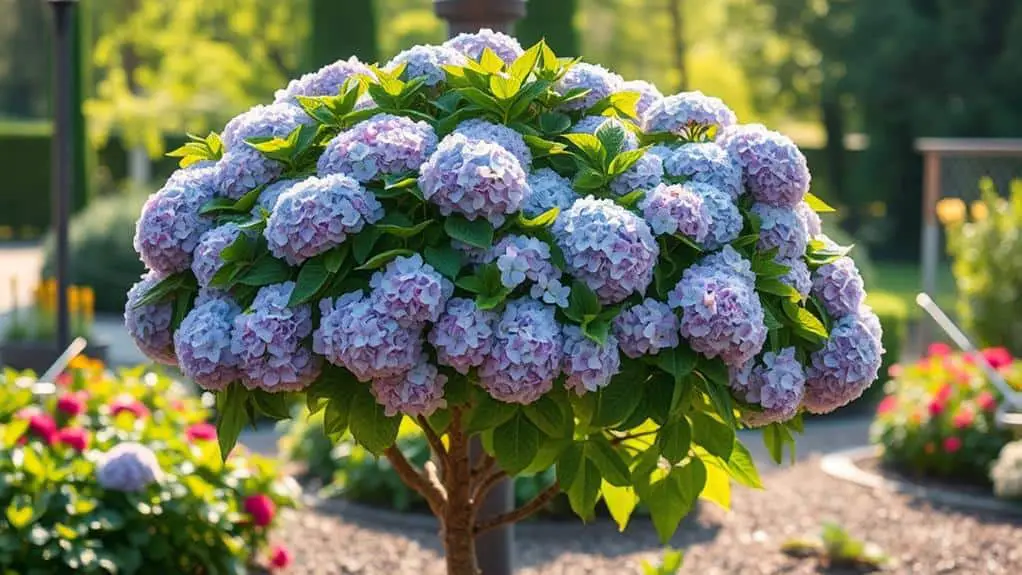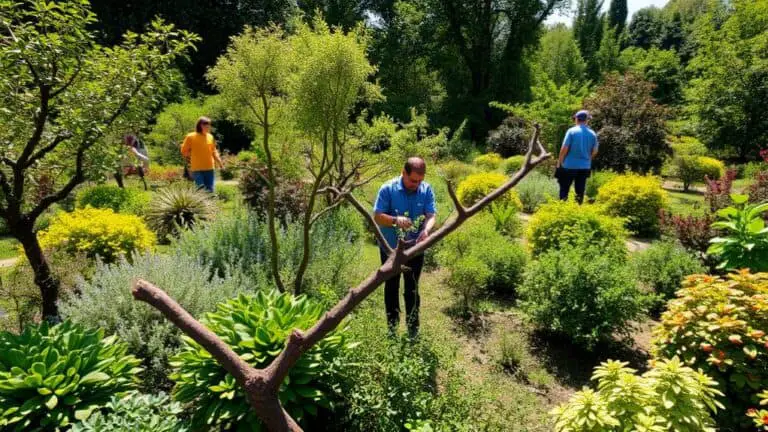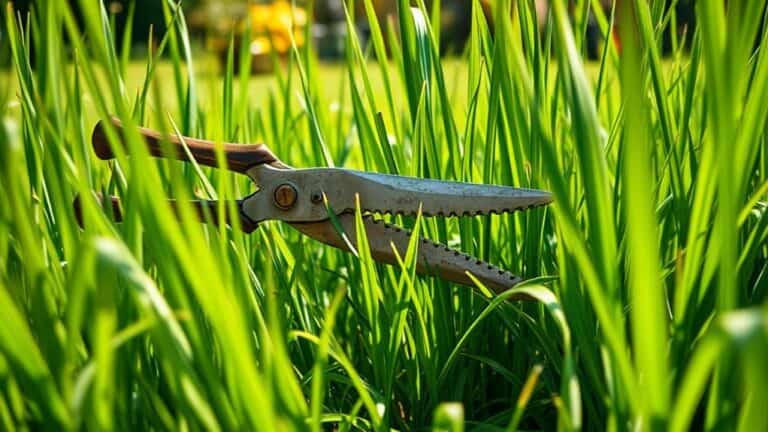Can You Turn A Hydrangea Bush Into A Tree
I've often wondered if it's possible to transform a hydrangea bush into a tree, and after some research and experimentation, I found that it is indeed feasible. The key lies in choosing the right variety and properly training the plant from an early stage. But it's not as simple as just letting it grow; consistent pruning and attentive care are essential. Have you ever thought about the specific steps involved and the common mistakes to avoid? There's a lot more to uncover about this fascinating gardening endeavor.
Choosing the Right Hydrangea

When it comes to transforming a hydrangea bush into a tree, choosing the right type is vital. The best choice is a panicle hydrangea, scientifically known as Hydrangea paniculata.
Varieties like Limelight, Quick Fire, and Pinky Winky are popular due to their strong growth habits and resilience. Start by selecting a healthy specimen with a long, straight stem. This is essential for successful tree shaping and stability.
You'll find that these types have thick stems, which provide better support for the tree form. Other hydrangeas, like Macrophylla, aren't as effective because they need winter protection to bloom.
Initial Planting and Training
Planting your hydrangea in the right spot is essential for its success as a tree. Choose a sunny location that gets afternoon shade. This helps the plant grow strong and bloom beautifully.
Make sure the soil is average to well-drained, so the roots can establish well. Pick a healthy hydrangea bush with a long, straight stem to serve as the main stem for your tree.
When you start to train your hydrangea, prune smaller canes to focus energy on the central leader. This helps it grow upright for about a year.
Use a stake and ties to support the main stem, keeping it straight and stable during its early growth stages. With patience, your hydrangea can become a stunning tree.
Pruning for Tree Formation
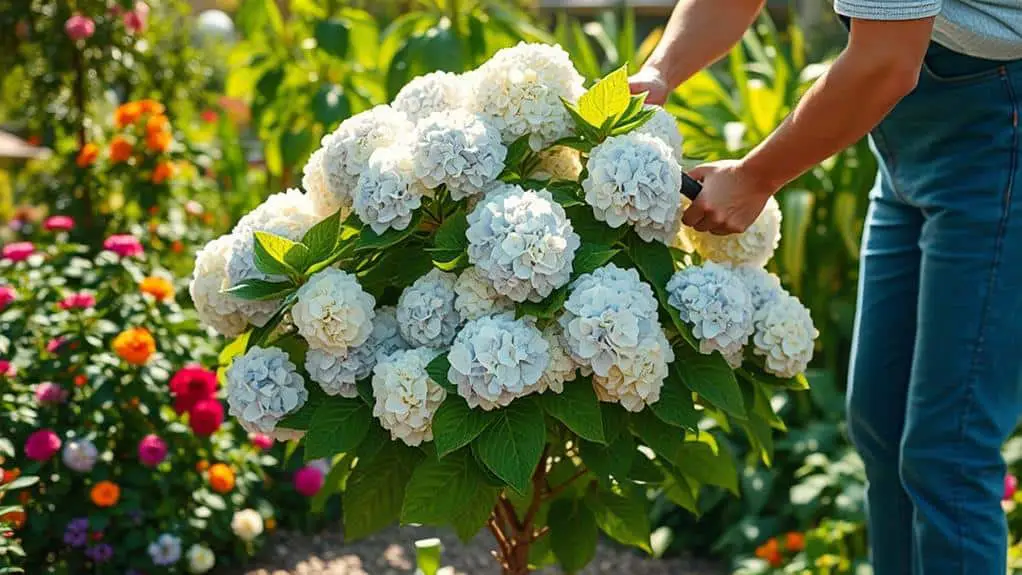
As your hydrangea begins to establish itself, it's crucial to start pruning for tree formation to guarantee a strong, attractive structure.
In spring, once your hydrangea reaches at least 24 inches, prune the main leader to initiate branching. This helps train your flowering shrub into a tree.
Focus on nurturing a strong central leader by removing smaller canes, letting the main stem grow upright and robust for about a year. Pruning terminal buds encourages horizontal growth, aiding in developing a fuller canopy.
Be patient; the tree form can take several years. Regularly remove dead wood and crossing branches, and monitor for emerging shoots.
Prune them as necessary to maintain your desired tree shape, ensuring consistent care throughout the season.
Maintenance for Desired Shape
To keep your hydrangea tree looking its best, a regular pruning schedule is a must.
Trim dead wood and any crossing branches to help the plant focus its energy on producing strong blooms and developing a healthy shape.
Patience is key, as consistent care and pruning will gradually shape your hydrangea into the tree form you want.
Regular Pruning Schedule
When maintaining a hydrangea bush trained as a tree, a regular pruning schedule is crucial for achieving the desired shape.
Regular trimming of dead wood and crossing branches helps direct energy toward strong growth and keeps the tree shape intact.
Here's what you should do:
- Prune in Spring: Focus on the main stem and remove any competing shoots to maintain a clear, central leader.
- Monitor for Shoots: Keep an eye out for new shoots and prune as needed to ascertain the main stem remains dominant.
- Encourage Horizontal Growth: Prune terminal buds to promote outward growth, enhancing the tree-like appearance.
- Routine Maintenance: Establish a consistent pruning schedule to care for your hydrangea bushes over several years.
With these steps, you'll nurture a beautiful hydrangea tree.
Encouraging Bloom Production
Encouraging bloom production in your hydrangea tree often requires diligent maintenance to secure it retains its desired shape and maximizes flowering potential. To start, regularly prune dead wood and crossing branches. This helps redirect energy to stronger bloom production. Consistent pruning promotes healthy growth patterns, which supports abundant flowering in your tree-form hydrangea. Keep an eye on the main stem and emerging shoots, pruning as necessary to prevent overcrowding. Ascertain a balanced shape by allowing adequate air circulation between branches. This can enhance bloom development. Additionally, fertilize during the growing season and deadhead spent blooms to improve the overall floral display.
| Task | Benefit |
|---|---|
| Prune dead wood | Stronger blooms |
| Maintain air circulation | Better bloom development |
| Fertilize and deadhead | Improved floral display |
Tools and Materials Needed
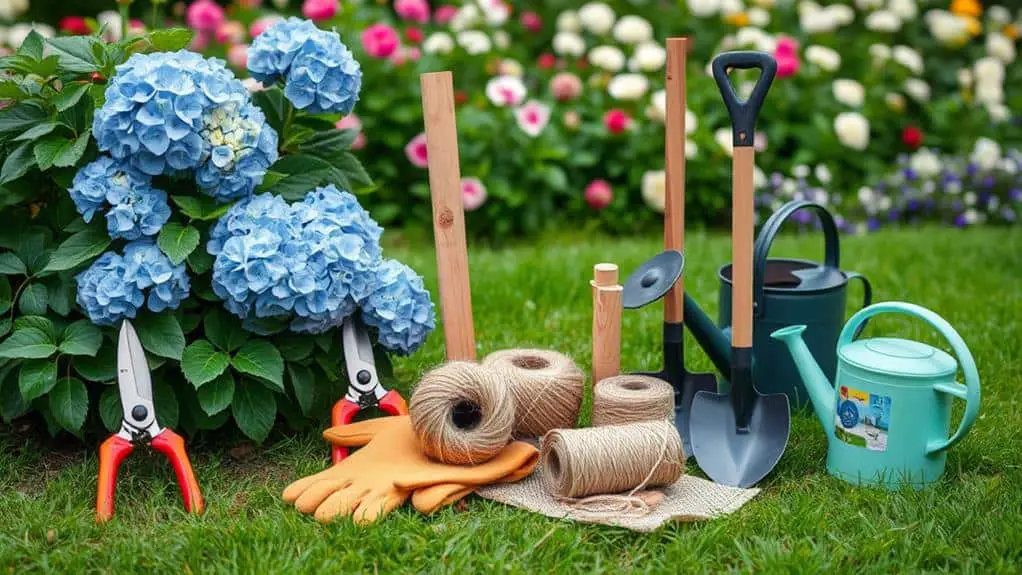
Transforming a hydrangea bush into a tree requires a few specific tools and materials to guarantee success.
First, you'll need a panicle hydrangea, like Quick Fire or Limelight, as they're perfect for tree training.
Here's a list of essential items:
- Sharp pruners or pruning shears: These are vital for cutting branches and shaping your plant.
- Tree stake and ties: These support the main stem, helping it grow straight and strong.
- Shovel: You'll use this to plant your hydrangea and make sure it's set in the ground securely.
- Healthy specimen: Choose a plant with a long, straight stem to act as the trunk.
With these tools, you'll be well-equipped to transform your hydrangea bush into a beautiful tree.
Selecting and Preparing Your Plant
Selecting the right hydrangea plant is essential for successfully creating a tree form. I recommend choosing panicle hydrangeas like Quick Fire or Limelight. These varieties have strong, straight stems and produce large blooms, making them perfect for tree training.
Look for a healthy hydrangea with a long, single stem to serve as the trunk. Guarantee it has thick stems for better stability.
When preparing your plant, clean the root ball by pruning off unnecessary leaves, flowers, and branches. This will help expose the root system, making it easier to see during planting.
Also, identify a natural splitting point for future propagation. Maintaining a healthy root system guarantees your hydrangea tree will establish well and thrive.
Training and Planting Steps
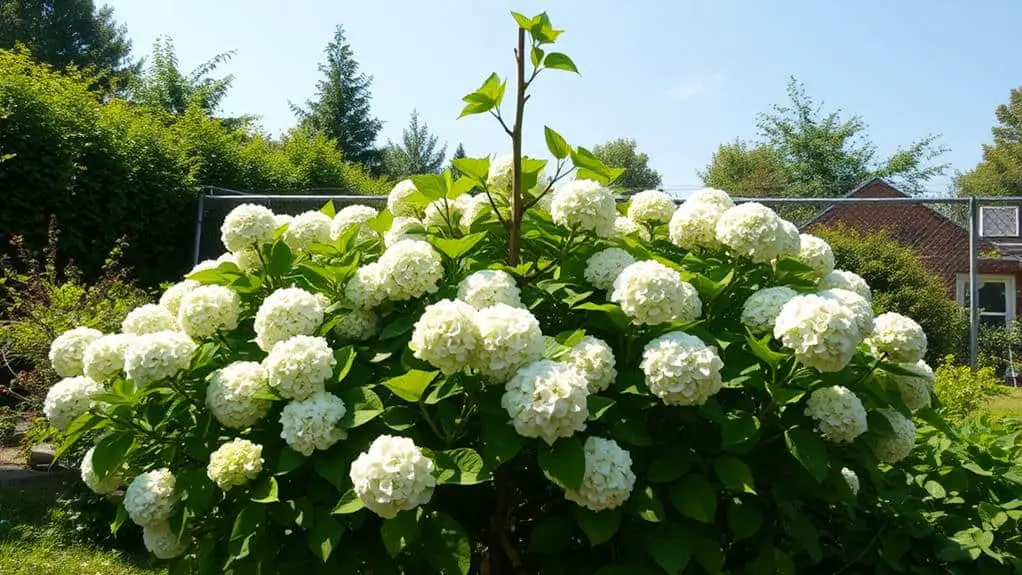
Starting the training and planting process for your hydrangea tree is straightforward but requires attention to detail. Here's how to begin:
- Select a Healthy Hydrangea: Choose a panicle hydrangea with a long, straight main stem. This will be your central leader.
- Planting Location: Verify the spot is sunny but gets afternoon shade. The soil should be average to well-drained.
- Train with a Plant Stake: Securely stake the main cane to grow straight. Prune smaller canes to focus energy on the central leader.
- Pruning for Structure: After a year, start spring pruning to encourage branching. Regularly remove lower branches, dead wood, and any crossing branches to maintain the tree shape.
With patience and care, your hydrangea will thrive!
Growth Monitoring Challenges
Growth monitoring is vital for successfully transforming your hydrangea bush into a tree. You'll need to keep a close eye on the main stem and side branches to guarantee they can support the weight of flowering blooms. Younger branches are more delicate, so be gentle with pruning. Watch for yellowing or dried leaves, as these could signal heat stress, especially in warmer climates. Patience is key, as this transformation takes years. Consistent pest monitoring is also essential; pests like whiteflies can seriously hinder growth.
Here's a quick reference table:
| Challenge | Sign to Watch For | Action Needed |
|---|---|---|
| Heat Stress | Yellowing or dried leaves | Provide shade or increase watering |
| Branch Fragility | Thin or weak young branches | Gentle pruning, support structures |
| Pest Infestation | Presence of whiteflies | Regular pest control measures |
| Bloom Support | Weak main stem, side branches | Regular assessment and reinforcement |
Stay vigilant, and you'll see your hydrangea bloom into a beautiful tree!
Community Engagement Tips

Connecting with fellow gardeners can make your journey of transforming a hydrangea bush into a tree both rewarding and informative. Engaging in community gardening allows you to share experiences and gain valuable insights on hydrangea care.
Here are some tips to help you connect with other gardening enthusiasts:
- Join local gardening groups or online forums: These communities are great places to exchange best practices and seek advice.
- Document your journey: Share photos and updates to encourage feedback and tips from others.
- Attend community gardening events or workshops: These gatherings offer opportunities to learn from experienced growers.
- Utilize social media: Connect with others by using hashtags related to hydrangeas and share relevant content.
Best Hydrangea Varieties
When it comes to turning a hydrangea bush into a tree, panicle hydrangeas are your best bet.
Varieties like Limelight, Quick Fire, and Pinky Winky aren't only robust but also produce stunning blooms.
These types thrive in USDA zones 3 to 9, making them perfect for many different climates.
Top Hydrangea Choices
Choosing the right hydrangea variety can make a significant difference in transforming a bush into a stunning tree.
Panicle hydrangeas (Hydrangea paniculata) are your best bet, thanks to their tall growth habit and massive cone-shaped flower clusters. Here are my top choices:
- Limelight: Known for its creamy white blooms that turn pink as they mature, offering a dynamic color display.
- Quick Fire: Blooms earlier than most, with flowers that change from white to a deep pink.
- Pinky Winky: Features large, bi-colored blooms that start white and turn pink from the base up.
- New Wood: All these hydrangeas bloom on new wood, so you can prune them in late winter or early spring without losing flowers.
Ideal Growing Conditions
To cultivate a hydrangea that transforms from a bush into a tree, you need to focus on providing the ideal growing conditions.
Start with a Hydrangea Shrub variety like Limelight or Quick Fire, which are great for tree training. Plant your hydrangea in well-drained soil enriched with organic matter.
Choose a spot that gets morning sun but offers some afternoon shade to protect the plant. Consistent moisture is essential, so water regularly, especially during dry spells.
Pay attention to the soil pH to achieve the flower color you desire—blue in acidic soil and pink in alkaline soil.
With these ideal growing conditions, your hydrangea will thrive and transform beautifully from a bush into a tree.
Frequently Asked Questions
Can Hydrangeas Become Trees?
Yes, hydrangeas can become trees. By selecting the right flowering varieties and focusing on plant care, you can manage hydrangea growth through tree pruning. This process enhances garden design and creates a stunning focal point.
Is There a Difference Between a Hydrangea Bush and a Hydrangea Tree?
As a gardener, I know hydrangea varieties differ in growth habits. A bush is fuller and shorter, while a tree is taller with a crown. With proper pruning techniques and maintenance tips, you can shape them for landscape design.
How Do You Turn a Bush Into a Tree?
To turn a bush into a tree, I use training methods and pruning techniques. I focus on the growth habits and root structure, ensuring proper seasonal care. Regular pruning shapes the main stem and promotes a tree-like appearance.
Can Hydrangeas Look Like Trees?
Yes, hydrangeas can look like trees. By using hydrangea pruning techniques and understanding hydrangea growth habits, you can create a striking hydrangea tree. Benefits include unique garden focal points. Follow hydrangea planting tips and guarantee seasonal care.
Conclusion
Turning a hydrangea bush into a tree is totally doable with the right steps. Choose a strong variety, like the panicle hydrangea, and start training it early. Regular pruning and care are key. Don't get discouraged if it takes time; patience will pay off. Keep an eye out for pests and make sure to stake the main stem. With dedication and the right tools, you'll have a beautiful hydrangea tree to enjoy for years. Happy gardening!

